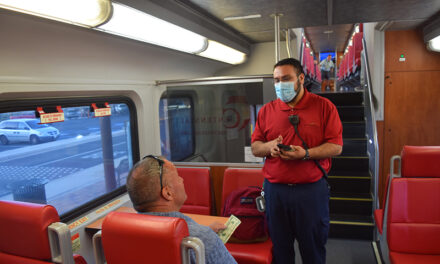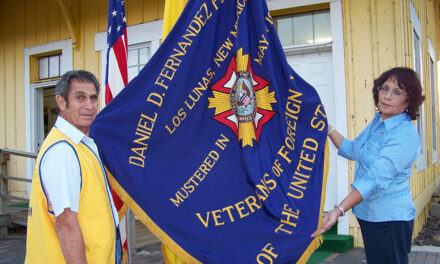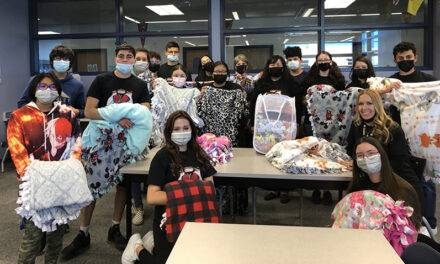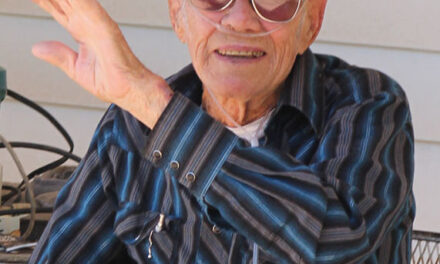La Historia del Rio Abajo
Pat Gomez was only 14 years old when she noticed a “help wanted” sign on the window of McLellan’s 5 & Dime store on Central Avenue in Albuquerque. When Pat went inside to apply for the job, Mr. Carr, the store’s manager, looked at the barely 5 foot tall girl and asked her age.
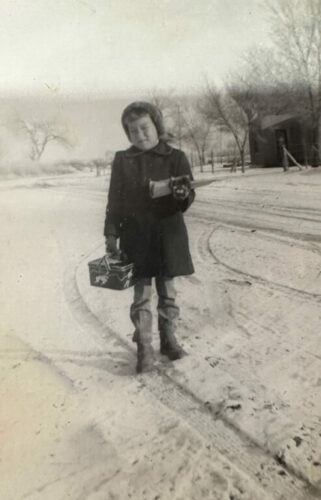
Courtesy of Pat Gomez
Pat Gomez waiting for the school bus at the far north end of Los Lentes Road, Los Lunas.
Pat knew she had to be 18 to work but, sure that she couldn’t pass for that age, answered, “15.”
Mr. Carr gave Pat the job anyway, telling her that he admired her “gumption.” Pat went to work and proved that Mr. Carr’s first impression was quite accurate.
In fact, Mr. Carr’s evaluation of Pat’s character has remained accurate throughout her life. It was Pat’s gumption that helped her survive a broken home and great poverty in her childhood.
Rather than let her circumstances deter her, Pat used her intelligence, personality, resourcefulness and gumption not only to survive but also to become one of the most successful businesswomen in all of Valencia County today.
Early years
Pat was born on Nov. 23, 1946, in Westwood, Calif., just west of Los Angeles. She was the oldest of three sisters.
Margie was born two years after Pat, and Bridgette was born a year after Margie. Their parents were Seldon and Rita Baca.
Pat’s parents moved quite often, uprooting to southwest Arizona and then back to California. Pat’s dad often jumped freight trains to get jobs in road construction and the timber industry.
Sadly, Pat’s father suffered from alcoholism, and her parents divorced when she was only 9 years old. Destitute, Pat’s mother packed up her three young girls, returned to her hometown of Los Lunas and moved in with her father, Augustin Villa, on the far north end of Los Lentes Road.
A widower, Augustin lived in a two-room house that was small for him, no less for the addition of his daughter and her three children. The family had no electricity, no running water and no indoor plumbing. Pat and her sisters had to use oil lamps to do their homework each evening.
After many days of making adobes, the family added a kitchen, but it burned down when one of Pat’s sisters played with matches and caused a fire. They never rebuilt the kitchen. Somehow, they got by, with Pat’s grandfather doing most of the cooking.
Pat and her sisters helped with the chores, hauling water, chopping wood for their wood stove and assisting in the slaughter of pigs and lambs. Pat hates the taste of menudo to this day.
With little cash for doctors or hospitals, Pat and most of her neighbors relied on curanderas — or natural healers — to deal with everyday medical needs. Pat remembers a particularly trusted curandera who lived on Route 47.
If a person suffered from a stomach ache, the curandera would roll an egg along his or her stomach until she found the area that hurt the most. She’d removed a thin layer of skin from that surface of the stomach and, inevitably, the person would be cured.
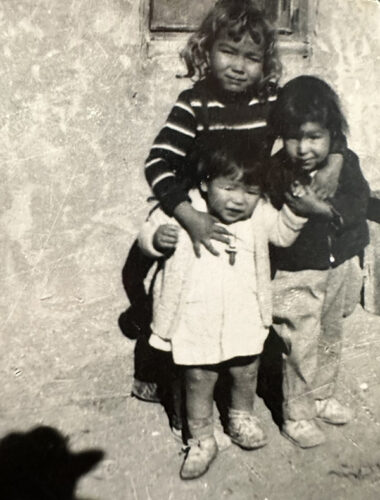
Courtesy of Pat Gomez
Pat Gomez with her two younger sisters, Bridgette and Margie.
The girls had no store-bought toys such as dolls or jump ropes. Instead, they played outside and made their own toys and games. They often played at the acequia, floating things downstream and running ahead to intercept them.
Angered whenever anyone put objects in the acequia that might clog the flow of water, their grandfather punished them by sending them to bed without dinner.
Pat admired her grandfather for many reasons, but especially for his resourcefulness. Speaking both Spanish and Tewa, he had close ties to the people of nearby Isleta. He traded goods at the pueblo and drove a buggy to Isleta’s St. Augustine church each Sunday morning.
When neighbors in Los Lunas bought one of the first television sets in town, Pat, her sisters and grandfather would sometimes visit to watch TV shows, especially the popular “Amos ‘n’ Andy.”
Pat enjoyed the neighbor’s TV so much that she asked her grandfather why they didn’t have one of their own. Augustin did not mention that they could not afford a TV and had no electricity to run it even if they could. Instead, he said he did not want one because he was sure that televisions were destined to lead to the destruction of the world.
Meanwhile, Pat’s mother worked hard to earn a living and keep her small family together. Each day, she woke up early, waved down a Greyhound bus on old Route 85, and rode to Albuquerque, where she made two bus transfers before she arrived to work as a housekeeper for well-off families in the northeast part of the city. She earned just 75 cents an hour.
Pat’s family was poor, but she hardly realized it because so many of their neighbors in Los Lunas were equally poor and managed to get along.
In Albuquerque
Pat, her mother, Rita, and her sisters experienced considerable poverty and hardships in Los Lunas. But conditions grew worse when Pat’s grandfather died and the family had to move to Albuquerque to be closer to Rita’s work.
Rita was often so strapped for cash that she had to “jump rent” when she could not afford to pay the rent at the start of a month. The girls received charity clothes and the family qualified for government-issued commodities that included the “best cheese ever,” but also the worst powdered milk, in Pat’s opinion.
Pat remembers the day that she and her sisters were scavenging at a dump and found a large box of new shoes. The girls were thrilled when they opened the box, but their excitement soon turned into disappointment when upon closer inspection they discovered that all of the shoes were for the left foot only.
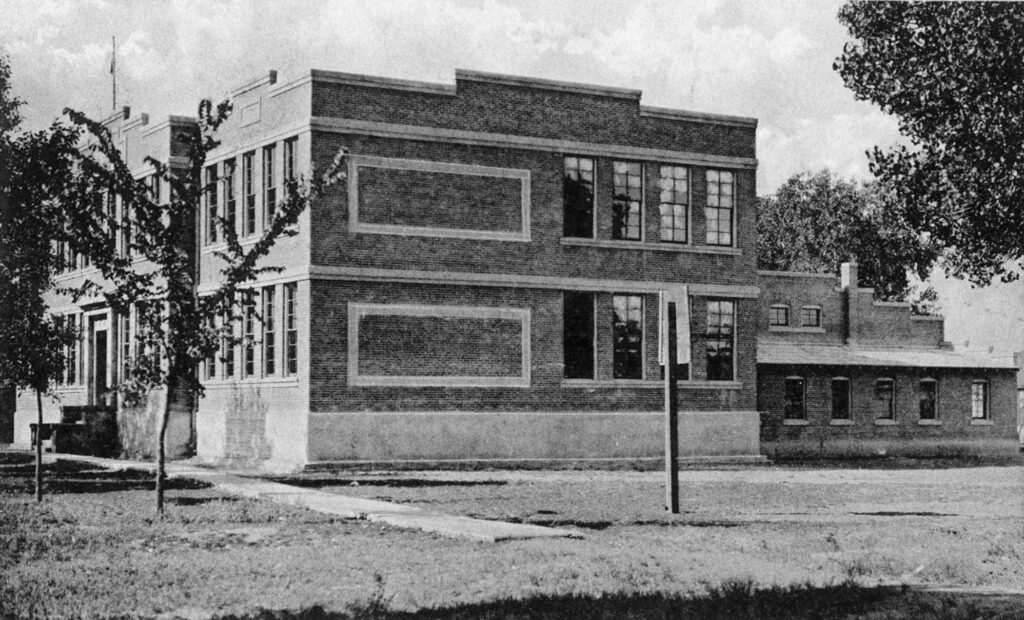
Author’s collection
McLellan’s 5 and Dime Store, Central Ave., Albuquerque.
Holidays were particularly tough. The family was so poor that Pat never received Christmas gifts until she was 9 years old.
As resourceful as ever, Pat took her sisters caroling and, after receiving money from rich families who liked their singing, bought a Christmas tree. They dragged their tree all the way home and decorated it the best they could.
Friends and neighbors were often helpful. Pat remembers the Thanksgiving when a neighbor brought the family real milk, homemade cookies and a chicken he had just slaughtered and delivered to their door in a bag. It was a Thanksgiving feast like none other for Pat’s family.
One Christmas, Rita was excited to see a man coming up to their house carrying a gift. Rita jumped to the conclusion that it was Seldon, who had seldom visited his daughters since he and Rita had divorced. Rita was disappointed when the man turned out to be one of her bosses.
But she and her girls were grateful for the gift the man brought them— a portable record player with two records. Pat even remembers the songs on the records they received, Elvis Presley’s “Love Me Tender” and Gogi Grant’s “The Wayward Wind.”
(Part 2 of this two-part article will appear in next week’s News-Bulletin.)
(La Historia del Rio Abajo is a regular column about Valencia County history written by members of the Valencia County Historical Society since 1998.
Opinions expressed in this and all columns of La Historia del Rio Abajo are the author’s alone and not necessarily those of the Valencia County Historical Society or any other group or individual.)

Richard Melzer, guest columnist
Richard Melzer, Ph.D., is a retired history professor who taught at The University of New Mexico–Valencia campus for more than 35 years. He has served on the board of directors of the Valencia County Historical Society for 30 years; he has served as the society’s president several times.
He has written many books and articles about New Mexico history, including many works on Valencia County, his favorite topic. His newest book, a biography of Casey Luna, was published in the spring of 2021.
Those interested in joining the Valencia County Historical Society should contact Dr. Melzer at [email protected].
